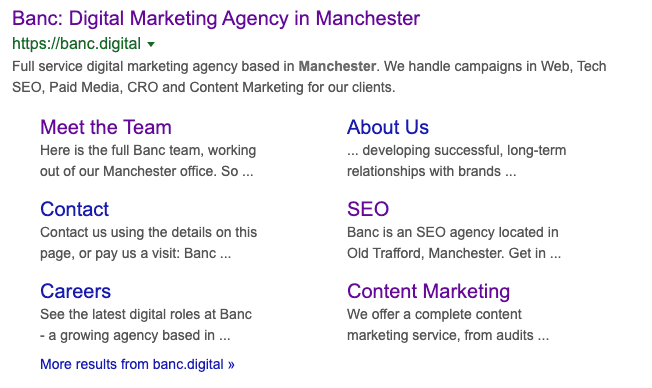Why Site Structure is Important for SEO – and How to Plan Yours
Get to know what site structure is and why it’s important in our definitive guide.
Site structure is how a website’s pages are set up and organised. It’s an important part of SEO optimisation, facilitating greater control over which pages are more visible in search results. It also bolsters user experience, ensuring simple navigation that maximises conversions.
Site structure determines how pages and links are arranged and categorised. By developing an intuitive site hierarchy, Google and users will find it easier to navigate your site – ensuring that nothing gets lost, and everything is easy to find.
Below, we take a closer look at why site structure is important for both SEO and UX, and ways in which you can improve your website architecture.
Quick Links
Why is the Structure of Your Site Important?
Improves the Crawlability of Your Site for Search Engines
Google uses search bots (or ‘spiders’) to crawl your site and discover content. If the site structure is optimised, the bots will find it easier to crawl – encouraging rankings and site performance.
The deeper and more complex your site architecture, the longer the crawl will take. And this matters, because all sites have limited crawl budget – the time and number of URLs a crawl bot is happy to spend on a specific site.
By optimising site structure, you’re effectively helping crawl bots to help your site. An intuitive, hierarchical site architecture improves crawlability, ensuring optimal use of crawl budget.
Enables You to Prioritise High-Performing Pages
Not only does an optimised structure make crawling your site simpler for bots, it allows you to influence what they see and prioritise. Developing an integrated site hierarchy through the use of consistent URLs is a powerful way to prioritise content and make crawl bots work for you.
URLs aren’t simply web addresses; they’re an actionable page element that can influence the structure of your site and the hierarchy of its pages. By building a coherent URL structure, you’re telling Google and your users which pages are important and how they correlate with one another – ensuring your site is contextual, intuitive and easy to navigate.
Optimises Site Structure for Improved UX
All users which land on your site are there for a reason – whether it’s for information, a quote, or to make a purchase. By ensuring your site structure is optimised, they’ll be able to find what they need more easily – boosting conversions and brand advocacy while reducing bounce rate.
Given the competitive sphere in which most businesses operate online, ensuring your site structure appeals to users is a must. An optimised site structure is one that allows users to convert in just a few clicks, without the need to deep-dive into a complex site architecture to find what they’re looking for.
Influences Site Links in SERPS to Improve Relevancy
Site links are additional links which are autogenerated in SERPs, appearing beneath the primary search result. They’re designed to help visitors jump ahead to a specific page, simplifying the user journey.
Here’s an example of site links in action:

Because site links are autogenerated, there’s no way to manually control which appear in SERPs. However, by developing a logical and hierarchical site structure, you can influence which pages Google links to – ensuring that any site links are relevant to the user’s original search query.
Improves Overall SEO Performance
The structure of your site holds significant sway over its organic search performance. How your pages are structured can directly affect how well they rank, so it should be a key consideration in your SEO strategy.
For example, if your site has poor navigation, this could influence bounce rate, which will in turn have a negative impact on SEO. Elsewhere, how your pages are interlinked will determine how well they rank for specific terms, and encourage a balanced share of link authority throughout your site architecture.
How to Improve Your Site Structure
Audit, Remove and Consolidate Existing Content
As your site grows and develops, it can be hard to stay on top of legacy pages and content which is out of date or duplicated. This is often the case for transactional, e-commerce sites, which have lots of product, offers and seasonal pages.
One of the first steps in improving site structure is tackling these cluttered pages. Removing, updating or consolidating pages will ensure that any structural improvements you make have the best possible impact.
Tip – when removing pages, make sure to redirect the existing URL to a new page with a 301 redirect. This will ensure any link value is passed on, without being lost.
Understand User Behaviour
Getting to grips with what users want from your site can have a significant influence on how you structure your pages. By gaining a deeper understanding of your site’s users, you can make structural improvements based on quantitative data, ensuring an optimised user experience.
Begin by developing a set of customer personas which define your audience, including what they want from your brand. Before making significant changes to the structure and navigation of your site, use A/B testing to refine and tweak specific elements to ensure your pages deliver from a UX perspective.
Review Categories and Site Hierarchy
Categories play an important role in developing an ordered and logical website. By dividing content into relevant categories, you’re effectively balancing your site – ensuring that it’s easy to navigate and not overly complicated.
When reviewing your site’s categories, consider what your main areas of focus should be and how specific pages relate to others. It’s better to have more categories with fewer pages contained within each, than lots of content split across just a small handful. This ensures your site is accessible and easy to navigate for both users and search engines.
Develop a Website Silo Architecture
Siloing refers to a website’s internal link structure. When a site is optimally structured, internal linking can help crawl bots understand the relationship between relevant pages – which is invaluable from an SEO perspective.
By grouping semantically similar pages together in ‘silos’, this informs search bots of the pages’ intrinsic relevancy. This not only provides greater context to encourage rankings, but also helps with things like site links.
Consider the URL Structure
When you’ve identified which categories make up your site’s overall structure, use this to inform your URLs. As touched on above, URL structure is an integral part of emphasising your site’s hierarchy, so developing a consistent approach across your site can bring significant value.
Here’s an example of how URL structure can inform your site hierarchy:
Build Breadcrumb Trails to Support UX Navigation
Breadcrumb trails are nothing new, but they remain an effective way to support site navigation. For users and search engines, breadcrumbs provide a quick, logical path between relevant pages, whilst also highlighting your site’s hierarchy.
Essentially, a breadcrumb trail bolsters your URL structure, making it immediately clear how pages relate to one another. They’re highly valued from a UX point of view, too, ensuring that users can navigate your site effortlessly en-route to converting.
Need help with your site structure? Banc can help. Our technical teams will work with you to develop a logical site architecture that’s optimised for users and search engines, ensuring that you attain maximum ROI for related marketing activity. To find out more, click here to visit the homepage or call us today on 0345 459 0558.



